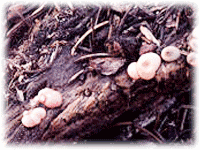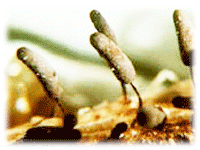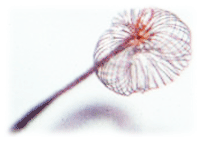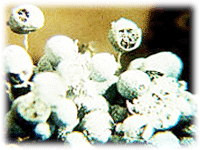
More Articles

“To process in order to regain materials for other uses” is the basic definition of “recycling.” Most rational people practice or at least believe in recycling in order to reduce the impact of waste materials on the environment. In the broad picture, recycling of organic materials is not a matter of choice but a fact of nature.
Fungi (molds, yeasts, and mushrooms) are major players in earth’s recycling program. By their digestive actions, fungi break down complex materials into simpler ones. A major part of human interaction with this recycling scheme is that we try to keep fungi, and molds from recycling our homes - or ourselves.
With sufficient moisture, mold will grow on virtually anything organic. Less dense materials recycle more quickly. For instance, drywall is an inorganic material, gypsum, covered with organic material, paper. Paper has a relatively low density as compared with most other building materials. With moisture added, drywall paper can be readily devoured (recycled) by molds. Denser materials like the wooden framing of our houses take a much longer period of time to become substantially altered by the actions of molds and other fungi.

There are a number of molds that are considered opportunistic pathogens, which means they prey on live organisms that are in weakened conditions. Molds invade organic matter to the degree that it is dead or dying. Thus molds are more likely to invade our bodies if our immune systems are compromised. A weakened immune system brings us closer to death and thus more susceptible to invasion by molds and other microbes. It follows then that the healthier we are, to a large degree measured by how effective our immune system is, the less likely we are to suffer ill effects from exposure to molds and other potential invaders.
Molds and other fungi predate humans on this planet by perhaps billions of years. It seems; however, that only in recent years have modern people come to realize that many common illnesses are possibly a result of exposure to molds rather than other toxins or pathogens. There is at least one passage in the Bible, however, that refers to the damaging effects of molds. Practitioners of medical science, particularly with the advent of Penicillin and subsequently other antibiotics, have been trained to deal with many or most diseases from the viewpoint that probable causes are bacterial or viral. To some degree, that viewpoint is now changing.
Two phenomena are at work here by my evaluation. The first phenomenon is a higher awareness of the kind of problems that can result from exposure to fungi (yeasts and molds, primarily) and fungal toxins. More and more stories concerning mold exposure are being printed or broadcast by the media. Many of the stories are somewhat sensationalized, but they do raise the general awareness that mold in your home is not benign and must be dealt with. The other phenomenon is simply a greater incidence of exposure to toxic molds.

News Magazine shows such as “60 Minutes,” “20/20,” and “48 Hours” have all aired segments devoted to “Sick Building Syndrome” (SBS), “Building Related Illness” (BRI) and/or mold infestation. More and more articles appear in newspapers and magazines especially when high profile individuals are affected by mold growth in their homes. While the media tend to sensationalize and does not always get everything right, I have not had major problems with much of their coverage. Conditions of having to totally abandon or demolish a house and discard all belongings, however, are usually radical and unnecessary solutions. Reasonable and effective methods of dealing with mold-contaminated buildings and belongings are adequately presented by such organizations as the U.S. Environmental Protection Agency (EPA) and the American Conference of Governmental Industrial Hygienists (ACGIH).
More incidents of mold exposure have occurred due to drywall and fiberglass insulation replacing plaster and lath walls as the predominant building material. This has occurred in the last forty or so years. This change in building materials has been one of the major contributors to the decreased quality of indoor air. Greater incidence of toxic mold growth in homes and commercial buildings is largely due to water intrusion resulting in mold contamination of drywall paper. Water finds its way inside such walls due to rain leaks, plumbing leaks, floods, or sprinkler water impacting on exterior walls, etc. Fiberglass insulation acts as a sponge, absorbing and holding water at or near the bottom of the wall or in other stopped locations. The paper on the interior of the drywall becomes soaked and may remain so for weeks. Between 48 and 72 hours after the water intrusion, mold growth begins. In a week or two if no action is taken and the drywall remains soaked, the notoriously toxic mold, Stachybotrys begins to overgrow the other molds. Molds recycle our homes, therefore, when we do not properly control moisture.

Another factor that adds to greater exposure to molds and mold toxins is a lack of fresh air. Houses are built tighter so that there is little outdoor air being admitted naturally. The effects of exposure to any contaminant are increased with a lack of outside air due to insufficient dilution. Fresh air essentially “water’s down” any contaminants so that they are less concentrated. Less concentration means a lower dose and therefore less detrimental effect.
“So why not just kill the molds and be done with it.” This is a frequent response from people when they are informed of the presence of mold growth in their home or workplace. First of all, mold does not just spontaneously begin growing on a surface. There are certain conditions required for mold spores to germinate. Mold spores are virtually everywhere. In order to substantially assure procreation, a mold growth site will produce its reproductive “seeds” or spores in very high volume. Spores are disseminated by water or air movement as well as other methods of locomotion, such as by sticking to body parts of animals.
In more cases than not, the spores will land on areas that do not have the necessary conditions for germination and growth. For a particular type of mold to grow, it requires a certain temperature range, an acceptable substrate or food source and sufficient moisture. Mold, as a collective entity will grow at a relatively wide range of temperatures. Since molds are among nature’s recyclers, they devour a very wide variety of materials. Substrates (food sources) include virtually anything organic or carbon based. Such materials are all around us; thus two of the three necessary conditions for mold growth (acceptable temperature range and a food source) are readily available. The one item that often has to be added is water. All you have to do is add water. To prevent mold growth in a building primarily requires controlling moisture because this is the one necessary condition that is generally controllable.
Mold's three pronged attack:
Many times I have heard the statement, “I had somebody come in and spray the mold to kill it, so I don’t see why there is still a problem.” The problem still exists simply because killing mold does not render it harmless. Mold can be harmful to humans, or to your pets in three ways.
Firstly, virtually any mold can be allergenic (cause allergy symptoms) with sufficient exposure. Allergic reactions to mold are primarily reactions to the material in the spores. It makes no difference in terms of allergic reactions whether the spores are dead or alive.
Secondly, many molds produce toxins that can be harmful to humans and animals. Toxins are usually present in the mold spores although there is some evidence that people can be adversely affected by the metabolites or mVOC (microbial volatile organic compounds), which are gases produced by digestive actions of the mold that are often characterized by earthy or musty odors. As with the allergens, much or the toxic material is present in the spores; thus it makes no difference whether the spores are dead or alive in terms of toxic reactions. It should be noted that adverse health conditions due to exposure by inhalation of mold toxins is a controversial subject and had not been clinically proven.
Thirdly, even though some molds are capable of growing at human body temperature so are potentially infectious, these molds are most likely to infect those persons who are immune compromised – small children, the elderly, cancer patients, transplant patients, AIDS patients, etc. Killing the mold renders the mold unable to grow so it cannot result in infection, which is, in reality, its recycling action. Infection is arguably the least likely reaction of the three harmful effects to occur due to mold exposure, at least for a healthy individual.
Killing mold only eliminates the least likely of the three ways mold can be hazardous. Dead mold spores are just as allergenic and/or just as toxic as live spores. As a matter of fact, if toxic material is used to kill the mold, the spores could then be rendered more harmful. Added to the toxins that are naturally in the mold spores, is another toxin that has been used to kill them.
Since with sufficient exposure virtually any mold can become allergenic for some individuals, mold growth inside a residence or place of business should never be ignored even if it is discovered that the growth is not one suspected of being toxic.
Two major molds common in indoor environments:
Mycotoxins are poisons produced by molds. Mycotoxicosis is a disease resulting from exposure to mycotoxins. In addition to Aspergillus and Stachybotrys, other potentially toxic molds commonly found in contaminated indoor environments include Penicillium, Chaetomium, Cladosporium, Fusarium, and Trichoderma. This is not by any means a complete list, however. Aspergillus and Stachybotrys are arguably two of the most significant mold types found in water damaged buildings. Again I want to point out that health problems resulting from inhalation of mold toxins have not been clinically proven.
Stachybotrys is the most notorious of the potential molds. Many believe its reputation is largely due to media hype. I, however, find Stachybotrys’ reputation to be well deserved. The poor state of health I find with individuals chronically exposed to this mold serves as ample anecdotal evidence for my conclusion. Stachybotrys has been shown to produce a toxin that inhibits protein synthesis. Certainly, to the degree a body cannot process proteins, it will waste away. Stachybotrys’ toxins also suppress the immune system and are toxic to the skin. Thus chronic exposure to even relatively low levels of Stachybotrys spores, whether alive or dead, can potentially produce detrimental health effects of a wide variety by reducing the effectiveness of the immune system. Again my evidence is solely based upon observation in the field.
Stachybotrys and its toxicity first came to world attention shortly after the Second World War when numerous horses in Soviet Ukraine were mysteriously dying. The horses’ caretakers and veterinarians were threatened with execution as they failed to find the source of the animals’ continuous deaths. It was finally determined that the horses were being fed hay that had become infected with mold. The mold that was killing the horses was Stachybotrys. This, of course, was toxicity by ingestion, not inhalation.
Stachybotrys’ notoriety was enhanced in the early 1990s when a number of children living in a Cleveland, Ohio ghetto became very ill with numerous health symptoms including pulmonary bleeding. Some of them died. The dwellings where the children became ill were all infested with Stachybotrys. This toxic mold was implicated in the illnesses and deaths. Recent studies by the Center for Disease Control (CDC) have concluded that, “Serious shortcomings in the collection, analysis, and reporting of data resulted in inflated measures of association and restricted interpretation of the reports. The associations should be considered not proven; the etiology of AIPH is unresolved.” (AIPH refers to Alveolar Idiopathic Pulmonary Hemosiderosis, or bleeding from the alveolar [small cavities or sacs] portions of the lung.) I do want to note, however, that I did not see any mention in the CDC paper related to this investigation of other molds that can result in pulmonary bleeding. Aspergillus often accompanies Stachybotrys in water damaged indoor environments. One symptom of Aspergillosis (Aspergillus infection) is coughing up blood.
Aspergillus is another one of the numerous molds that produce mycotoxins. Many species of this mold type are also potentially infectious.
The field of study relating diseases to exposure to molds is relatively young. One of the first documented cases of Mycotoxicosis was the 1960 death in England of many thousands of turkeys. The deaths were found to be a result of the turkeys eating peanuts contaminated with the mold, Aspergillus flavus. This mold can produce a toxin now known as Aflatoxin. One of the Aflatoxins, Aflatoxin B1, produced by A. flavus and other Aspergillus species, is recognized as the most carcinogenic (cancer causing) biological substance known. Aflatoxin is reportedly used in chemical and biological warfare. That the turkey incident was documented in 1960 illustrates just how young this field is.
Species of Aspergillus are the mold types most often implicated in human infections and disease. Aspergillus species are the most notorious mold for lung infections. Aspergillosis and “Fungus Ball” are two Aspergillus infections of the lung. The most noticeable symptom of such infections other than general respiratory difficulty is coughing up blood. These infections most often affect only immune compromised individuals. (There is some evidence that pulmonary bleeding can also be fostered by reactions to toxins such as the ones produced by Stachybotrys.)
Stachybotrys and Aspergillus are probably the two most important mold types in terms of indoor contamination. They are often found growing in the same contaminated indoor environment. While Stachybotrys and numerous species of Aspergillus can produce toxins that can be harmful to humans, in combination the health effects might even be worse than the two separately. Most infectious molds, including Aspergillus are usually opportunistic pathogens, or have greater infectious potential with individuals who are immune system compromised. Since toxins produced by Stachybotrys have been found to be immune system suppressive, I’ll let you do the math.
Mold or fungal infections can be serious and even life threatening, particularly for immune compromised individuals. Persons who are commonly so identified include AIDS and cancer patients, transplant patients, the elderly and young children. Certainly, anyone who is recovering from something as traumatic as a major operation or serious injury should be included in the category of persons more susceptible to infection whether viral, bacterial or fungal.






